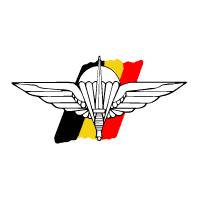History
During the Second World War, parachutist and commando units were founded in Great Britain. In January 1942 the first Belgian parachutists were trained at RAF Ringway, Manchester, England, to serve in the No. 10 (Inter-Allied) Commando. The same year, the Belgian Independent Parachute Company was established and commanded by Captain Eddy Blondeel.
Later, the unit was incorporated into Britain's Special Air Service Brigade and became the 5th Special Air Service (known as the Belgian SAS squadron). The SAS squadron was active during World War II until enemy activities were discontinued. They performed several operations using the parachute regiment and armoured jeeps. Thereafter, the unit also took part in counter-intelligence operations.
On 21 September 1945 5th SAS was transferred from the British Army to the newly reformed Belgian Army. Renamed as the Regiment of Parachutists SAS, they served independently as a highly mobile airborne unit until 1952. That year, the parachutist and commando units were brought together to form the Para Commando Regiment. Later, an antitank company, a field artillery battery and a reconnaissance squadron were added to the regiment.
In 1991, the regiment became the Para-Commando Brigade by adding new support units. In 2003, the Para Commando units (1st Paratroopers Battalion, 3rd Paratroopers Battalion, 2nd Commando Battalion) together with the 12/13th Battalion of the Line formed the new Light Brigade. It was stationed in Marche-en-Famenne.
On 3 July 2018 the Light Brigade was transformed into the Special Operations Regiment and its headquarter moved to Heverlee. The regiment consists of the two remaining Para-commando battalions (3rd Para, 2nd Commando), the Special Forces Group, the 6th Group CIS, the training centre for parachutists and the training centre for commandos. The 12/13th Battalion of the Line was transferred to the Motorized Brigade.
The Para-commando battalions work closely with the Belgian Air Force's 15th Air Transport Wing, who operate the Lockheed C-130 Hercules transport aircraft.
This page is based on this
Wikipedia article Text is available under the
CC BY-SA 4.0 license; additional terms may apply.
Images, videos and audio are available under their respective licenses.


